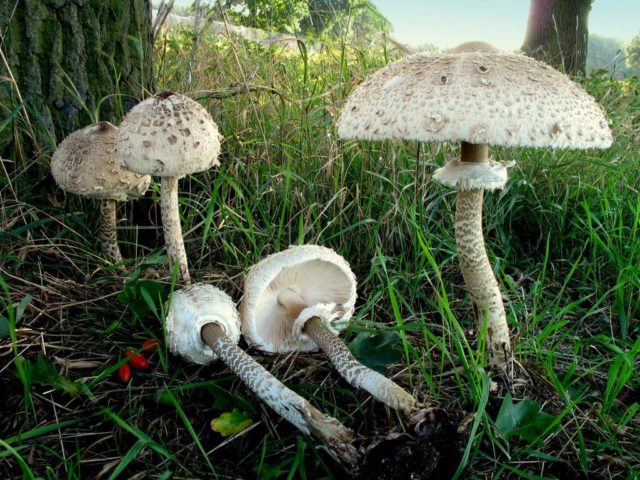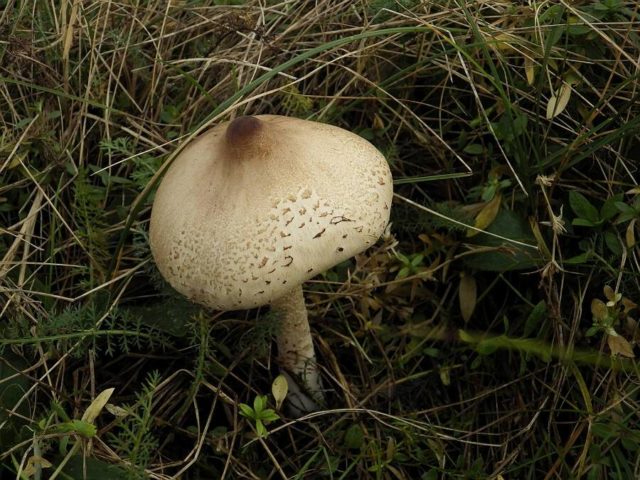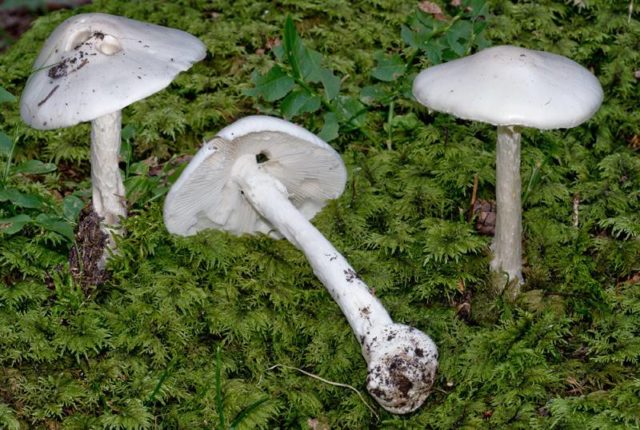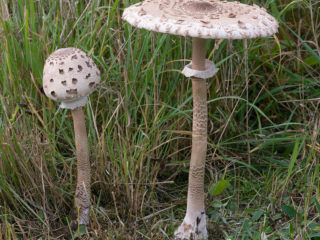Content
- 1 Description of umbrella mushrooms
- 2 Types of umbrella mushrooms
- 3 Is it possible to eat umbrella mushrooms
- 4 What does an umbrella mushroom taste like?
- 5 What are the benefits of umbrella mushroom?
- 6 Medicinal properties of umbrella mushroom
- 7 False doubles
- 8 Collection rules
- 9 Eating umbrella mushrooms
- 10 Conclusion
The umbrella mushroom is so called because of its similarity to this piece of clothing. The appearance of a large and wide cap on a long and relatively thin stem is quite characteristic, and it is difficult to find any other association. Most umbrellas are edible mushrooms with excellent taste. Their distribution area is very extensive. The following are photos and descriptions of umbrella mushrooms, and their gastronomic and medicinal properties are given.
Description of umbrella mushrooms
This group of related species is otherwise called macrolepiotes and belongs to the Champignon family. All of them are distinguished by a characteristic appearance, indeed very similar to an open umbrella. Most representatives of macrolepiots are edible mushrooms.
Where do umbrella mushrooms grow?
Umbrellas grow in forests, both coniferous and deciduous. They can even appear in parks and plantings. They are able to form mycorrhizae with almost any tree. They prefer dry, light areas (for example, clearings or forest edges), and are often found near paths.
They can also appear far from trees. There have been numerous cases of umbrellas being found in fields and meadows. They grow relatively rarely along the banks of reservoirs.
Each of the macrolepiots, even on its own, has a fairly large range. And if we consider the entire group, we can say that its representatives are found on all continents, with the possible exception of Greenland and Antarctica. Umbrella mushrooms can be found in the Moscow region and in the north of Australia.
When do umbrella mushrooms grow?
Fruiting of this group lasts almost all summer. The first mushrooms appear in early June. The last ones are in mid-September. Of course, a lot depends on the specific species. So, the variegated umbrella bears fruit from the third ten days of August to the first ten days of October, and the white one - from mid-June to the third ten days of October.
Growth rates in summer are much higher than in autumn. If the formation of a mature fruiting body in July takes several days, then in September this process (despite more rain) can last for 2 weeks.
What do umbrella mushrooms look like?
These are quite large mushrooms, the cap of which can reach very large sizes. Its diameters are recorded from 35 to 40 cm. The leg can also be very long (up to 40 cm). The top of the cap is powdered with many small scales. There are also representatives that have relatively large spots instead.
A typical edible umbrella mushroom (variegated) is shown in the photo below:

The cap of the ripe fruiting body of the variegated umbrella is covered with many small scales
Young fruiting bodies look like small balls (up to 10 cm in diameter) on relatively long and thin stalks. Over time, they open up and the outer shell, breaking in many places, remains in the form of scales on the caps. Photo of an unopened umbrella mushroom:

Unopened caps of young mushrooms have a more saturated color than those of adult specimens
What category do umbrella mushrooms belong to?
Since, despite their widespread occurrence, these are little-known and unpopular mushrooms, they are classified in the 4th category of edibility. An important role in this was played by the fact that their fruiting bodies should be consumed at a young age, while the pulp is still quite loose.
Young mushrooms can be prepared in any form (fried, boiled, salted, soaked, etc.) With age, their scope of use narrows significantly. It is not recommended to even dry old specimens.
Types of umbrella mushrooms
There are several varieties of edible umbrella mushrooms. Below they are discussed in more detail, their characteristic differences from the photo are given.
Variegated umbrella
A typical representative of the umbrella group. Another name is chicken mushroom, received for its similar taste to chicken meat. A large species, reaching legs up to 40 cm long (although the average is from 10 to 30 cm). The diameter of the cap is up to 35 cm. It has a late ripening period. A photo of a motley umbrella is shown below.

Young and mature fruiting bodies of the variegated umbrella
Umbrella white
Also an edible variety that is very popular. The dimensions are significantly smaller than those of the motley one (the cap is up to 15 cm in diameter, the leg is up to 12 cm long).The distribution area is much larger, since the fungus can grow both in forests and in open areas.
A characteristic feature is the ragged color of the cap on mature fruiting bodies. The pulp is white in color and does not change when cut. The taste is a little tart.

A white umbrella is characterized by a torn coloring of the cap.
Elegant umbrella
Edible mushroom. It has a thin stalk up to 15 cm long. The diameter of the cap is up to 18 cm. A characteristic feature is a tubercle in its center. It has tasty and aromatic pulp.
Found in warm temperate climates of Europe and Asia. Also widespread in northern Africa and America. In addition, there are large colonies of this fungus in Australia.

Elegant umbrella with a characteristic colored tubercle on the cap
Lepiots
In addition, there are a number of inedible umbrellas, mainly lepiots. Almost all of these species are smaller than their edible relatives. In addition to their short stature, their other characteristic feature is the presence of variegated pigmentation in the center of the cap.

Lepiota comb is a typical representative of inedible umbrellas
Is it possible to eat umbrella mushrooms
The question of whether an umbrella mushroom is edible or not has been resolved a long time ago. Almost everywhere it is eaten without any restrictions. Many people are afraid to eat this species because of its similarity to poisonous mushrooms, but the external differences between the umbrella and inedible related species, as well as from false doubles, are quite characteristic, and it is problematic to confuse them.
What does an umbrella mushroom taste like?
The taste of the variegated umbrella, like its related species, is similar to the taste of champignons. Young fruiting bodies are juicier and softer. Their gastronomic qualities are especially appreciated by gourmets due to their slight astringent effect.
What are the benefits of umbrella mushroom?
The beneficial properties of the umbrella mushroom are determined by the substances it contains. These include:
- tyrosine (normalization of the liver and hormonal system);
- arginine (improving metabolism and vascular function);
- melanin (supports normal skin condition);
- B vitamins;
- vitamins C, K and E;
- minerals - potassium, sodium, magnesium, iron.
In addition, the fruiting bodies of umbrellas contain a large amount of beta-glucans, which are immunostimulants.
Medicinal properties of umbrella mushroom
Traditional medicine recommends the use of this type of mushroom in various diets (due to their low calorie content), as well as as a protein food for diabetes.
Traditional healers believe that the beneficial properties of umbrellas can improve the condition of patients in cases of such diseases:
- diseases of the cardiovascular system;
- for rheumatism;
- nervous system disorders;
- oncology.
An important medicinal property of the umbrella is its immunostimulating and antioxidant effects.
False doubles
Due to the presence of characteristic elements in the structure of the stem and cap, this representative of the Champignon family has several dangerous doubles. All of them are poisonous, some are fatal. Below are the false doubles of the variegated umbrella.
Lead slag chlorophyllum
Refers to poisonous mushrooms. Outwardly very similar to an umbrella. It has a white cap, which is covered with brown or brown-pink scales. Its diameter can reach up to 30 cm. In young fruiting bodies it is dome-shaped, but as they mature it becomes flattened.
The leg does not exceed 25 cm in length, and its diameter ranges from 1 to 3.5 cm. Initially, its color is white, but in places of damage when exposed to air, its flesh turns brown.In this case, a section of a large area has a reddish tint. The color of the plates of young mushrooms is white.

Old fruiting bodies of Chlorophyllum lead-slag have gray-green plates
Distributed throughout the world, except in southern Asia and South America. However, it is found in Africa and Australia. Perhaps he got there with the colonists.
Chlorophyllum dark brown
It is also a poisonous representative of the mushroom kingdom, very similar to an umbrella. There are only minor differences in appearance. The fleshy and relatively thick cap has a diameter of up to 15 cm. The leg is short, about 9 cm in length and 1-2 cm in diameter. It has an almost regular cylindrical shape, but near the ground level there is a thickening with a diameter of about 6 cm.

With age, the stem and cap of the dark brown chlorophyllum acquire a brown tint.
The range of the fungus is relatively small. It is found on the east coast of the United States, as well as in parts of central Europe. Most often, dark brown chlorophyllum is recorded in the Czech Republic, Hungary, and Slovakia.
Panther fly agaric
A well-known representative of deadly mushrooms that are highly toxic. Its cap can reach 12 cm in diameter. In youth it is semicircular, in old fruit years it is flat. The leg reaches a length of 12 cm, a diameter of 1-1.5 cm.
A characteristic feature of the leg is a thickening shaped like a small potato. 80% of the legs have a ring located directly at the point of attachment of the hymenophore.

The edges of the panther's fly agaric cap are always cracking
The plates are white, but sometimes there are brownish spots on them - traces of injuries and insect activity. The flesh is white and remains the same when cut. The growing area is very wide; we can say that the mushroom is distributed throughout the Northern Hemisphere.
Stinky fly agaric
He's a white toadstool. A deadly poisonous mushroom with a 90% chance of death if consumed. The remaining 10% of cases cause serious poisoning, including disability. The color of the entire mushroom is off-white.
The cap is covered with peculiar flakes of irregular shape. Its diameter can reach up to 20 cm. Young fruiting bodies are characterized by a conical cap. At maturity it becomes slightly convex, but does not flatten. The color of the outer layer of the cap can vary from white to pink, while a dirty gray tint will always be present in the color.

The stinking fly agaric prefers open areas with low grass
The leg has a cylindrical shape. Its height rarely exceeds 15 cm, and its diameter is 2 cm. Distinctive features of the stalk are a flocculent coating, a ring and a tuberous thickening at the base.
The flesh of the fruiting body is white and does not change color when cut. The smell is pungent and unpleasant. Many note its similarity to the smell of chlorine-containing preparations and household chemicals. Widely distributed: found everywhere in Eurasia, northern Africa, the USA and Canada.
Collection rules
There are no specific techniques for collecting umbrellas. Mushrooms do not require any special conditions for transportation and storage. Their fruiting occurs depending on the variety at this time of year:
- in the reddened one from the beginning of July to the end of October;
- for motley - early August to late September;
- for white: late June and early October.
It is during these periods that the content of useful substances in the fruiting bodies of umbrellas is maximum.
Mushroom pickers especially appreciate the taste of the caps of young specimens. It is slightly astringent and sour. Therefore, it is young mushrooms that are recommended for collection. In addition, their use will be universal - such specimens are suitable for frying, pickling, and preparing soups and salads.
Eating umbrella mushrooms
Depending on the age of the fruiting bodies, their consumption may vary. Only young mushrooms have versatility of use. Already ripe specimens are not recommended, for example, to be fried or salted. The best option for them would be to use them as a protein base for soup or a main course. You can also consider stewing for them.
It is recommended to use only young mushrooms for pickling. Older ones (with a straightened cap) are a compromise solution; over time, their taste may change.
It is better not to cut off old fruiting bodies at all, but to leave them in the forest. But if it so happens that an overripe representative ends up in the basket, it can be dried.
Conclusion
The article presents photos and descriptions of umbrella mushrooms. This species is an edible representative of the Champignon family.The umbrella mushroom is found almost everywhere in Europe, America and Asia. Its ripening time is mid-summer and early autumn. The umbrella mushroom has many varieties. They differ slightly in appearance and collection time. In addition to edible umbrellas, there are also inedible representatives of the family, and poisonous false doubles are also very similar to them.








